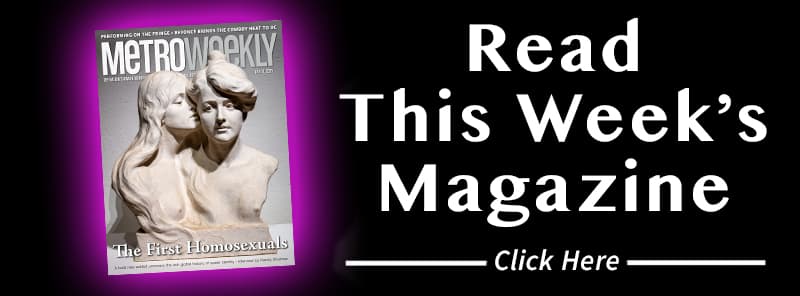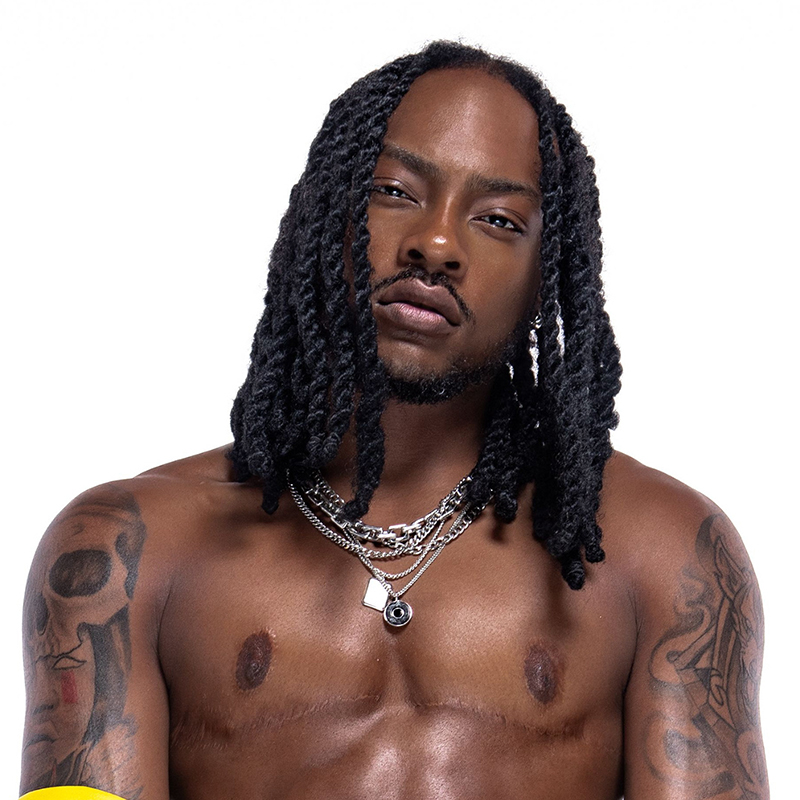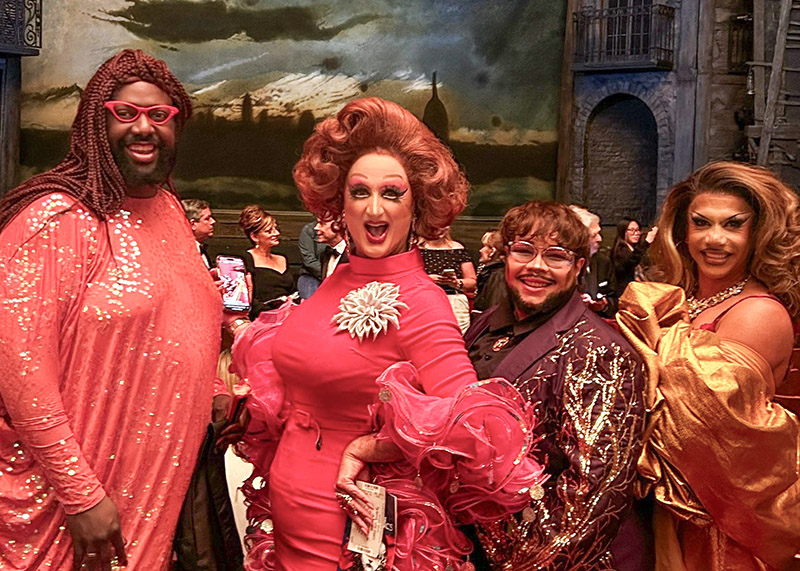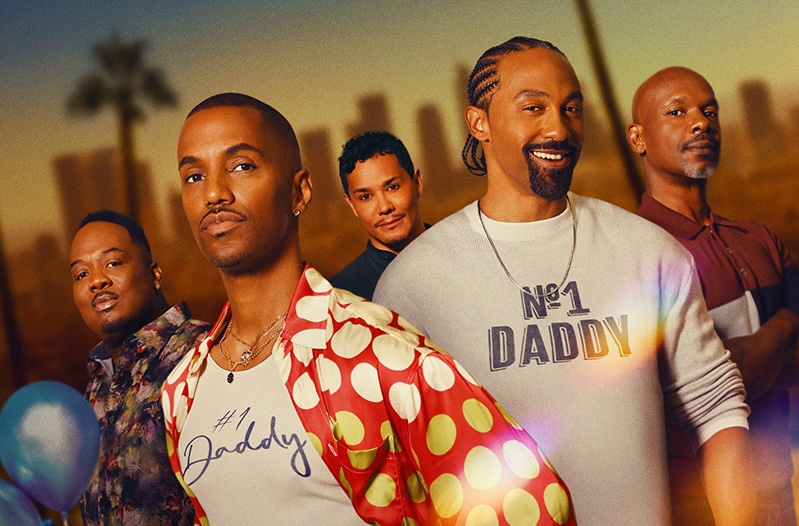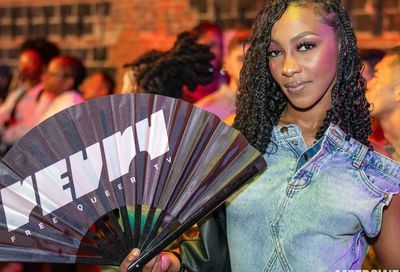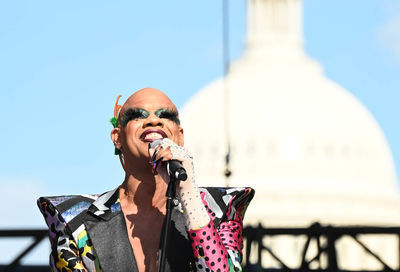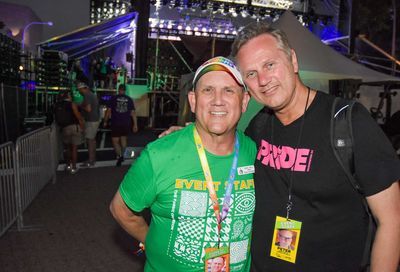Body Language
EDGEWORKS founder Helanius Wilkins makes movement his mission
If you talk about contemporary dance in Washington, dancer and choreographer Helanius Wilkins is bound to enter the conversation. Since 2001, his EDGEWORKS Dance Theater has steadily been gaining momentum, as he and his all-male company of mostly African-American dancers follow a mission to smash stereotypes.
“We come in as men, men who are dancing, men who are making an impact through dance,” Wilkins explains. “We’re not coming in as gay men or straight men. We’re coming to it just as men first. That’s where the work starts from. I think there’s something very special about starting from that place.”

That male-centric description may seem limiting to some, but it has certainly not limited Wilkins, who specifically dubbed EDGEWORDS a contemporary-dance “theater,” rather than a “company,” in that it allows him and others the opportunity to express themselves beyond dance.
“I’m a multimedia artist,” says Wilkins. “I’m interested in doing a lot of different things. In our larger productions, we tend to have elaborate set designs, costuming, original texts, original music. I’m usually contributing to various aspects of that.”
Next up, Wilkins and company will be closing out the season with a performance on the Kennedy Center’s Millennium Stage. Then Wilkins is off to Switzerland to perform in the International Choreographers’ Showcase. Rather than marking his international debut, however, Switzerland follows appearances on stages in Scotland and Lithuania.
His age aside — there are some secrets Wilkins would like to keep during this journey of exploration — Metro Weekly was lucky enough to pin him down for an hour to learn more about the man.
METRO WEEKLY: Tell me about this upcoming performance on the Kennedy Center’s Millennium Stage.
HELANIUS WILKINS: It’s actually going to be a really exciting program. I will be introducing five brand-new dancers who have been working with me. The new company has been working together less than six months. I’m really thrilled with all these dancers. I find them to be really amazing individuals, really intriguing artists. I can ask for nothing more than artists who inspire me and contribute to an environment that allows great things to happen.
MW: Will there be a particular mood or theme to what you’re presenting?
WILKINS: It’ll be a mixture. It will be a sampling of some of our repertory from the past. My work has ranged from small works to large works, dealing with a variety of themes that are politically relevant and socially inspired. For example, one of the works that we’re doing is “I Catch Myself” from my most recent completed work, which was exploring gender, sexuality and spirituality.
We’re also developing a brand-new work. We’ll be giving a sneak preview of that. It’s a real journey that I’m exploring. I think ultimately it’s going to lead to a deeper conversation, a heavier conversation, involving relationships in dealing with class and race and how economic conditions affects one’s choices.
MW: Tell me how you ended up in Washington.
WILKINS: My move to Washington was quite spontaneous. I moved here from upstate New York. I was in Rochester. I felt that I’d accomplished everything that I wanted to accomplish there. I was ready to go. I had one friend at school there who was from the Washington area. She would always say, “Helanius, feel free to come visit Washington. My family would love to see you.” She was one of my best friends. “You’ll always have a place to stay.” The call ended up being that I was not coming to visit, but that I was moving to Washington.
Sure enough, a week later I came here and shook a few hands, made some introductions at various dance venues and universities that had programs. While I was in college, I always knew that one day I would have my own dance company. I’m very much “right brain” and “left brain.” I strategize all the time. I started to research areas where I wanted to live, not just as personal places I would I enjoy but as places where I could see myself doing my work and keeping that as my main priority. Washington was one of those places. So, along with that, came conversations and discussions and researching to collect names of individuals I might want to connect with, make contact with, have conversations with about the dancing and Washington, what I might be able to expect. I did come with some information and some names, though I had not necessarily met those people.
I discovered Washington to be a place where I could develop my voice, my craft, and keep it as my main priority, and as a place where I would be afforded the opportunity to be close to other areas that I wanted to have access to, those being Philly, New York, Boston and Chicago. It came back to “What is really important for me?” Definitely in the very beginning of any dancer’s career, a choreographer’s career, there is a process of planting roots and growing and developing this ability for your work that will hopefully flourish into something more substantial. Oftentimes, people who are artists go the route of doing what they have to do to survive, and then they carve out time and space to keep their art alive. I came with a different mentality, which was to make sure my art stayed first. So in some ways I think I’m a rare case because I can honestly say that I’ve been in my field the entire time. That’s about my greater interest, which is not just about choreographing and performing, but being an advocate for the field, being a teacher, being interested in arts education. I’ve always found a way to make work and survive in my field.
MW: The arts scene in D.C. has transformed since you arrived in 1995. Do you agree? If so, do you think you’ve contributed to that?
WILKINS: In the time that I’ve been here, I’ve seen things shift multiple times. There are periods where there seem to be an overwhelming number of artists coming through and developing work and you feel that the scene is very alive and very vibrant and very diverse. There are other periods where it feels likes you’re searching for who’s out there. In some ways, I feel like a contributor to what’s going on in that I do believe Washington has some staples, some companies, some artists who are really making an impact on the way in which the Washington arts scene is viewed outside of the area, through touring and interacting outside. It changes the perception that good dance doesn’t exist in Washington and it gives another frame of reference. I think, as locally based artists, what we also struggle with is that Washington is a major presenting city, so everybody comes and tours to Washington. With the attention given to those companies, it can be easy to forget that you actually have some homegrown or locally based artists doing great work.
MW: In retrospect, do you still think that choosing D.C., rather than, say New York or Chicago, was the best choice for you?
WILKINS: Absolutely. I’m very much one who lives in the moment. I don’t live in regret. I have no regrets. The decisions I make for myself I feel are the best decisions I can make at the time.
I can honestly say that once I uprooted myself and officially moved to Washington, there was a period early on when I questioned whether or not I should pack back up and move on. [Laughs.] But that gave me the drive, the internal push to say, “Okay, if you’re desiring certain things, make them happen.” So, with that attitude and that energy in me, presenting the option to pick up and move or start developing something, I chose to start developing something. In the end it really gave me the opportunity that I always wanted and dreamed of having for myself, and that was to be able to focus on my work, develop my craft, build a body of work and eventually establish a company.
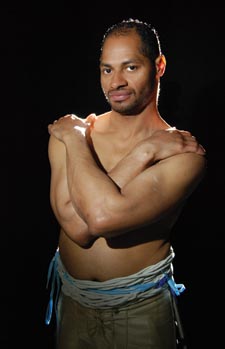
Helanius Wilkins
MW: With all that you’ve built since you’ve arrived, not only founding EDGEWORKS but working with other dance companies and teaching, what’s a typical week like for you?
WILKINS: I don’t know if I have a “typical” week. What I can tell you is that every week, generally, is loaded with activity. Sometimes it can be quite exhausting. I’m very much a workaholic. I move about quite a bit.
But on the other end of that — it feels weird what I’m about to say because I just had this conversation with my company during rehearsal — when I look at the greater scope of what I’m doing, I’m living my dream. I feel very fortunate and very blessed to have been a young individual who was able to recognize his calling and spend my life putting everything in place to do what I do today.
Down the road, what I’m interested in doing is just further grounding what I do and just pulling everything together, more tightly together, under one umbrella versus being out as much and interacting with different organizations, although that is another interest of mine. But I feel that the shape of my relationships with other organizations could be crafted differently. Because something that is also important to me is collaboration. I think in today’s time, collaborating holds the key to survival, to existing, to re-energizing the arts.
MW: All arts, or dance in particular?
WILKINS: All arts. It’s coming back to having a dialogue. It’s coming back to establishing relationships that everyone who’s involved could benefit from.
I will say, I often feel that dance — contemporary dance or modern dance — is perceived as the thing that is hard to understand, not as tangible, and therefore harder to gain funding for, harder to build audiences for. Ballet has a different kind of access to people because of its history, its forms. There are three styles of ballet. You know what you’re going to get in a ballet class. You know what you’re typically going to get at a ballet performance. But in the contemporary world, it’s one person’s vision, translated and fused with all of their personal experiences and what they bring to the table. So you don’t necessarily know one company from the next, one artist from the next. It could be like day and night.
MW: More narrowly, how much teaching do you do?
WILKINS: I have four standard classes I teach on an ongoing basis. The greater part of my teaching happens in the way of “guest artist,” residencies, teaching master classes.
There are professionals who are in the classes. Definitely there are people who love dance, who have taken it in the course of their lives and are rediscovering it, finding it as adults. There are others who are in training, semi-professional dancers who are getting deeper into their craft in the hope of dancing professionally. It’s very mixed, very diverse.
MW: What about your childhood? When did you start connecting with your body?
WILKINS: I don’t know if I can pinpoint an exact age, because for me, I feel like it’s all I’ve known. There’s something in that rooted to my personality. Most people think I’m extroverted. I’m actually introverted. During my childhood, I was very shy. I hear many stories from my family, still, to this very day, of how I would express myself. It was always through movement, not through talking.
At some point in that journey, what ultimately happened was that I saw a PBS special on Alvin Ailey and Mr. Ailey saying, “Hi, I’m Alvin Ailey and I’m a choreographer.” That was the physical moment for me.
Prior to that, I was always very physical, always very expressive in my body. That was the place I felt most confident expressing myself. How I transformed and built from that point is that I was a jock — a complete jock. I ran track, I played basketball, I did it all. I studied the martial arts. All of those things are very much a part of who I am today, because they inform the work that I do. It feels like it was a form of cross-training for what I do. My work is often very athletic, extremely physical. I’m often interested in speed, how through speed you can still give some window into emotion and feeling and human connectivity. I’m fascinated by the idea of defying gravity.
MW: Boys are certainly encouraged to be jocks, but dancing can be a trickier prospect. Were you dancing while you were growing up in Lafayette, La.?
WILKINS: I started training toward the end of high school. There is a big difference between the South and the North. [Laughs.] There is a more conservative view of things, typically, in the South; and more diversity, a greater sense of merging in the North, I feel. On the other hand, Louisiana is no different than any other place.
In general, dance has carried the stereotype, has often been viewed as a field for women only. That is one of the things that brings me to dance, to really shatter those stereotypes and show that dance is actually a place — a real place — and a vehicle for men to be able to express themselves. It’s where they can be powerful and strong, and yet be vulnerable at the same time. Dance is like any other sport — if not better than, because you have to do so much more, in terms of your body.
MW: Going back to stereotypes, EDGEWORKS is dedicated to smashing some. Give me an example.
WILKINS: The biggest one being that dance is solely a field for women, where the job of the male dancer is to make the woman look pretty. That’s a big one.
We, as individuals, have a lot to say. We have a lot of experiences. We question. We think. We reflect. We struggle. We have moments of success. All of those things are indicative of real stories, stories that can be shared. That’s a part of it. Also, looking at what it means to be masculine. What does it mean to be a male in America? There are stereotypes rooted in that, like some very old statements of “men don’t cry” to men don’t have a gentle side or a soft side.
I strive to explore the voice in its completeness. Not one side of it, one view or one angle, but the voice in its completeness. The way I do that, in part, is through making myself the most open person and artist that I can be in my journey, to listen, to engage with my fellow artists who work in my company, or when if I’m developing projects with collaborators, or with everyday people about their experiences, their views, because my perspective about something might be very different than experiences that another has. It’s the layering of those perspectives, putting them side by side, seeing where they are alike, where they collide, where are they different, where they stem off from each other. That grid is really more of a reflection of what it’s like to be male.
MW: The mission gets more specific than exploring male experience, but African-American male, specifically.
WILKINS: That part of it is about who I am. I’m an African-American male. So I’m looking at it, on one hand, through my eyes, the experience, the work I do. On the other end of that, there’s the connection or another scope of work that I’m interested in exploring that is about the greater African-American male voice. Today it still happens in some ways that the voice of the African-American male is not necessarily always seen as a universal voice, if you will. We live in a world where we find comfort in boxing people in, placing labels on them to identify them, versus eliminating those barriers and finding the places where we’re more alike. I think with my work there’s a real opportunity to have conversations, to witness struggles, stories, successes, experiences, and actually be able to see how we are more alike than different, and therefore the voice of the African-American male is just as universal as any other voice.
MW: Did you have strong male influences when you were growing up?
WILKINS: I definitely have had strong male influences in my life. I’m sure that I’m bringing all of those experiences to bear, that they at some point impacted my journey, my process, how I think. Then there’s another part that may exist in a place of my personal experiences. For instance, growing up in the South, going to a private, Catholic high school where I was maybe one of six African Americans. So you’re isolated. You live with being the minority and what comes with that. All of those things shape you and get you thinking about certain things. I’m always analyzing and searching deeper and doing that soul searching. Oftentimes I have to pull myself out and say, “Oh, Helanius, it’s not that deep.” [Laughs.] I’m the person who’s asking the questions. “What else can this become?” “Where does this stem from?” “How did it get to this point?” “Where can we go from here?” It’s that kind of soul searching.
MW: Since leaving Lafayette, have you brought your dance full circle? Has your family seen you perform?
WILKINS: Absolutely. My parents are incredibly supportive. They’ve traveled to see the company perform, including coming to Washington a couple of times. They’re very enthusiastic. I’m very fortunate for that.
In some ways, I also feel that it comes with the greater making of my family. I do feel that I’m surrounded and connected to a family of artists. My mother’s side of the family, everybody’s played musical instruments. Very artistic, visual artists. On my father’s side of the family, they were tradesmen, people who designed, did welding and built things, structural, architectural.
I have a brother and a sister, and we’re very close. They are both artists in their own right. My brother is in social work and my sister is a teacher. Somehow, we’ve all found ourselves to be doing something that’s ”noble” work. [Laughs.]
MW: When you dance or teach, is that nurturing in the same way as your brother helping his clients, or your sister teaching her students?
WILKINS: Yes, because ultimately I believe what I am striving for is to connect with the individuals who come to see my work, come to see my company perform, and connect in a way where we break down that third wall, to have a dialogue, to have a conversation about whatever, to experience the arts, to let the art lead us to something else that can hopefully lead us to making a difference in some way, seeing life differently, allowing us to become better humans.
I do believe that dance is the universal language. Anywhere you go, we can interpret, or make assumptions based upon someone’s behaviors, gestures, movement. If someone is walking a certain way, we may get a sense of them being not confident. Or you might get the feeling that someone is very assertive. The way in which we navigate is very telling of who we are as individuals.
The work we’re doing, there’s a place for everyone because it’s about embracing diversity. It’s about bridging gaps, building community. Our work is about real issues, real life, and energizing and uplifting us to be the best we can be.
EDGEWORKS Dance Theater performs Friday, April 24, at 6 p.m. on the Kennedy Center’s Millennium Stage. This is free performance. EDGEWORKS also presents Spring Sizzle, a fundraising event, Monday, May 18, from 6 to 10 p.m. at Busboys & Poets, 1390 V St. NW. For more information about EDGEWORKS Dance Theater, call 202-483-0606 visit them online at www.hjwedgeworks.org.
Support Metro Weekly’s Journalism
These are challenging times for news organizations. And yet it’s crucial we stay active and provide vital resources and information to both our local readers and the world. So won’t you please take a moment and consider supporting Metro Weekly with a membership? For as little as $5 a month, you can help ensure Metro Weekly magazine and MetroWeekly.com remain free, viable resources as we provide the best, most diverse, culturally-resonant LGBTQ coverage in both the D.C. region and around the world. Memberships come with exclusive perks and discounts, your own personal digital delivery of each week’s magazine (and an archive), access to our Member's Lounge when it launches this fall, and exclusive members-only items like Metro Weekly Membership Mugs and Tote Bags! Check out all our membership levels here and please join us today!







